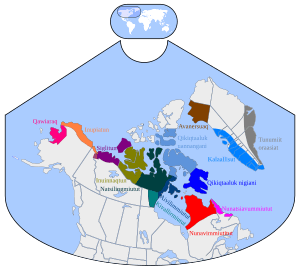Tunumiit dialect facts for kids
Quick facts for kids East Greenlandic |
|
|---|---|
| Tunumiit oraasiat | |
| Native to | East Greenland |
| Ethnicity | Tunumiit |
| Native speakers | (3,000–3,500 cited 1995) |
| Language family |
Eskimo–Aleut
|

Inuit dialects. Tunumiit is grey.
|
|

|
|
Tunumiit oraasiat or East Greenlandic is a unique language spoken in eastern Greenland. It is the language of the Tunumiit people. While it's often seen as a special kind of Greenlandic, it's so different that some people think it's almost its own language!
The biggest town where East Greenlandic is the main language is Tasiilaq. This town is on Ammassalik Island. The island's name actually comes from the West Greenlandic name for the town.
Contents
What is East Greenlandic?
East Greenlandic is a language that belongs to a bigger group called the Inuit languages. These languages are spoken across the Arctic, from Greenland all the way to Canada and Alaska. East Greenlandic has its own special sounds and words that make it different from other Greenlandic languages.
Where is East Greenlandic Spoken?
This language is spoken in the eastern part of Greenland, which is a very cold and beautiful place. This area is called Tunu. The people who live there, the Tunumiit, have used this language for a very long time. It helps them share their stories and traditions.
Who Speaks East Greenlandic?
About 3,000 to 3,500 people speak East Greenlandic. These are mostly the Tunumiit people. They live in small communities along the coast of East Greenland. For them, speaking East Greenlandic is a big part of their identity and culture.
Why is East Greenlandic Special?
East Greenlandic is special because it has changed differently from West Greenlandic. Imagine two cousins who grew up in different places. They might both speak the same language, but they'll have different accents and some different words. East Greenlandic is like that, but even more so! It has unique features that make it stand out.
Is East Greenlandic in Danger?
Sadly, East Greenlandic is considered a "definitely endangered" language by UNESCO. This means that fewer and fewer young people are learning to speak it. When a language is endangered, it means that the culture and history connected to it could also be lost. People are working to help keep the language alive for future generations.

